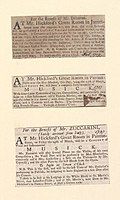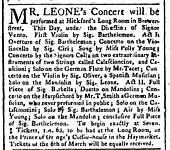
Peter Scheemakers or Pieter Scheemaeckers II or the Younger was a Flemish sculptor who worked for most of his life in London. His public and church sculptures in a classicist style had an important influence on the development of modern sculpture in England.

The Concert for Bangladesh was a pair of benefit concerts organised by former Beatles guitarist George Harrison and Indian sitar player Ravi Shankar. The shows were held at 2:30 and 8:00 pm on Sunday, 1 August 1971, at Madison Square Garden in New York City, to raise international awareness of, and fund relief for refugees from East Pakistan, following the Bangladesh Liberation War-related genocide. The concerts were followed by a bestselling live album, a boxed three-record set, and Apple Films' concert documentary, which opened in cinemas in the spring of 1972.

Joseph Joachim was a Hungarian violinist, conductor, composer and teacher who made an international career, based in Hanover and Berlin. A close collaborator of Johannes Brahms, he is widely regarded as one of the most significant violinists of the 19th century.

The Licensing Act 1737 is a defunct Act of Parliament in the Kingdom of Great Britain, and a pivotal moment in British theatrical history. Its purpose was to control and censor what was being said about the British government through theatre. The act was modified by the Theatres Act 1843 and was finally named as the Theatres Act 1968. The Lord Chamberlain was the official censor and the office of Examiner of Plays was created under the Act. The Examiner assisted the Lord Chamberlain in the task of censoring all plays from 1737 to 1968. The Examiner read all plays which were to be publicly performed, produced a synopsis and recommended them for licence, consulting the Lord Chamberlain in cases of doubt. The act also created a legal distinction between categories of "legitimate theatre" and "illegitimate theatre".
Matthew Dubourg was an English violinist, conductor, and composer who spent most of his life in Ireland. Among other achievements, Dubourg led the orchestra at the premiere of Georg Friedrich Handel's great oratorio Messiah.

Pieter Hellendaal was a Dutch composer, organist and violinist.

James John Joicey FES was an English amateur entomologist, who assembled an extensive collection of Lepidoptera in his private research museum, called the Hill Museum, in Witley, Surrey. His collection, 40 years in the making, was considered to have been the second largest in the world held privately and to have numbered over 1.5 million specimens. Joicey was a fellow of the Zoological Society of London, the Royal Geographical Society, the Royal Entomological Society, the Royal Horticultural Society, and the Linnean Society of London.

The Kneisel Quartet was a string quartet founded in 1885 by violinist Franz Kneisel, then concertmaster of the Boston Symphony Orchestra. It continued to perform until 1917, and was generally considered the leading string quartet of its time in the United States.

The Mozart family grand tour was a journey through western Europe, undertaken by Leopold Mozart, his wife Anna Maria, and their musically gifted children Maria Anna (Nannerl) and Wolfgang Theophilus (Wolferl) from 1763 to 1766. At the start of the tour the children were aged eleven and seven respectively. Their extraordinary skills had been demonstrated during a visit to Vienna in 1762, when they had played before the Empress Maria Theresa at the Imperial Court. Sensing the social and pecuniary opportunities that might accrue from a prolonged trip embracing the capitals and main cultural centres of Europe, Leopold obtained an extended leave of absence from his post as deputy Kapellmeister to the Prince-Archbishopric of Salzburg. Throughout the subsequent tour, the children's Wunderkind status was confirmed as their precocious performances consistently amazed and gratified their audiences.
Michael Christian Festing was an English violinist and composer. His reputation lies mostly on his work as a violin virtuoso.

Giulia Frasi was born c. 1730 and died in 1772 or after May 1774. She was an Italian soprano who was primarily active in London. She sang in every one of Handel's English oratorios, including various world premières for which the composer wrote roles specifically for her.

Feliks Janiewicz, in English often Felix Yaniewicz was a Polish composer and violinist in exile.
George Saville Carey (1743-1807), was an entertainer and miscellaneous writer.
William Hatchett was an English translator, dramatist and pamphleteer. He was born and went to school in York, but by the late 1720s was living in London, where he remained for most of his life. Hatchett appears to have been a long-time partner of Eliza Haywood; some of Hatchett’s works were also either co-written with, or published by, Haywood.

The British Symphony Orchestra is the name of a number of symphony orchestras, active in both concert halls and recording studios, which have existed at various times in Britain since c1905 until the present day.

Francisca "Paquita" Madriguera Rodon was a Catalan pianist and composer, based for much of her adult life in Uruguay.

Gabriele Leone was an Italian musician and composer who lived in Paris during the middle and later part of the 18th century. A virtuoso on the violin and mandolin, he wrote an early mandolin method, Analytical method for mastering the violin or the mandolin in 1768 and composed for both instruments. He was an early teacher of the duo method, an advanced technique which would reappear in the 20th century, taught by Giuseppe Pettine in the United States.

Domenico Colla was an 18th-century Brescian composer and performer who traveled Europe in the 1760s, performing in the most important theaters and salons. Together with his brother Giuseppe, he was one of the Signori Colla, or the Colla brothers. The brothers played in royal circles; they performed before Frederick the Great in 1765 in the palace at Sanssouci. They were in London in 1766, where it was advertised that they had performed before the British royalty, as well as other the royal families of Europe. The brothers were also noted for being survivors of slavery in Algiers, rescued from it by the King of Poland.

Gaspard Fritz was a Genevan violinist and composer of the pre-classical period. He composed symphonies and chamber music.

Neale's Musick Hall, also known as Mr. Neal's New Musick Hall, Mr. Neale's Great Room, Neal's Musick Room, the Great Musick Hall, Neale's Great Musick Hall or the Fishamble Street Music Hall was a purpose-built music hall that existed on Fishamble Street in Dublin city centre. It was built using subscriptions from a charitable organisation named 'The Charitable and Musical Society', and operated from 1741 until the mid-19th century. William Neale, a local musical instrument-maker and music publisher, was the secretary/treasurer of the society during the conception and construction phase of the project. The building is most notable for the premiere of Handel's Messiah which took place within it on the afternoon of 13 April 1742.




























